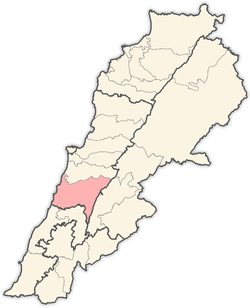Baakleen
| Baakleen بعقلين | |
|---|---|
| City | |
 Baakleen Location within Lebanon | |
| Coordinates: 33°40′47″N 35°33′30″E / 33.67972°N 35.55833°ECoordinates: 33°40′47″N 35°33′30″E / 33.67972°N 35.55833°E | |
| Country |
|
| Governorate | Mount Lebanon Governorate |
| District | Chouf District |
| Area | |
| • Total | 14 km2 (5 sq mi) |
| Highest elevation | 920 m (3,020 ft) |
| Lowest elevation | 850 m (2,790 ft) |
| Population | |
| • Total | 17,000 |
| • Density | 1,200/km2 (3,100/sq mi) |
| Time zone | EET (UTC+2) |
| • Summer (DST) | EEST (UTC+3) |
| Dialing code | +961 |
| Website |
www |
Baakleen (or Baakline) is a city located in Mount Lebanon, Chouf District, 45 kilometers southeast of Beirut. Altitude 850 – 920 meters high, population is 17,000, area 14 square km, number of homes 2,870. Bordering Towns: Deir El Kamar, Beit Eddine, Aynbal, Deir Dourit, Symkanieh, and Jahlieh.
History
Founded in the 12th century by the Maan emirs, Baakline served as their capital until the early 17th century when its most famous Emir Fakhreddin II, moved to Deir el Qamar. Today Baakline is an important Druze town and seat of the sect's religious leader. The beautiful grand serail, the main administrative building of Baakline before World War II, has been restored and transformed into a public library. In the center of the village stands the palace of Sheikh Hussein Hamadeh, built in stages starting in 1591. In the area of the Serail are some Druze religious buildings of the 18th and 19th centuries, including, khalwats, (meeting places), and a maqam, or tomb. Additional to Ain Aldiaa water source and "Abou Shakra" family historical houses . Baakleen holds an important place in Lebanon’s history.
The roots of Lebanon as we know it today go back to Baakleen. Around the year 1120 A.D., Amir Maan Ibn Rabeaah, the great grandfather of Amir Fakher Eddine Al Maani the second who established “Lubnan Al Kabeer”, settled in Baakleen with his tribe. He was supported by his in-laws, the Tanoukhyeen. Amir Maan was married to the daughter of Amir Noaaman Al Tanoukhy. Historians agree that Baakleen was the capital of the Maani Emirate.
Due to water shortages in Baakleen, the Maani Amirs were attracted to Neighboring Deir Al Kamar (according to Druze archives, called Dar Al Kamar), where they built many palaces and a mosque that still stands in the middle of the town square carrying the name of Amir Fakher Eddine Ibn Othman Ibn Al Hajj Younis Al Maani (1493 AD). The last of the Maan family Amirs was Amir Ahmad who died in 1697 A.D. and with his death, the rulers of the Emirate became the Shihab family who were tied to the Maan family through intermarriages and alliances.
Under the Ottoman rule, Baakleen came back to the forefront as one of the “Qasabat” or major towns. It served as the summer capital for the Druze “Qaem Makqam” or the local governor in the name of the Ottoman Sultan.
Baakleen is the sister town of Florence, Italy.
External links
- Baaqline, Localiban
